University of Phoenix LDR/300: Innovative Leadership Theories Report
VerifiedAdded on 2022/08/20
|12
|2614
|10
Report
AI Summary
This report provides an in-depth exploration of five prominent leadership theories: trait, behavioral, contingency, skills, and situational leadership. The trait leadership theory, as the oldest modern theory, focuses on innate qualities and characteristics that distinguish leaders from followers, with examples like self-confidence and determination. Behavioral leadership emphasizes the actions and behaviors of leaders, highlighting skills like human, technical, and conceptual abilities, as well as the importance of communication and motivation. Contingency leadership examines the interplay between a leader's personality and the situation, differentiating between task-motivated and relationship-motivated styles, and the importance of matching leadership style to the environment. Skills leadership focuses on the development of specific skills, such as human, conceptual, and technical skills, that contribute to effective leadership, emphasizing that anyone can become a leader through skill development. Lastly, situational leadership highlights the adaptability of leaders, who adjust their style to fit the needs of the situation and their followers, including styles such as directing, coaching, participating, and delegating. Each theory is illustrated with examples and supported by academic references to provide a comprehensive understanding of leadership approaches.
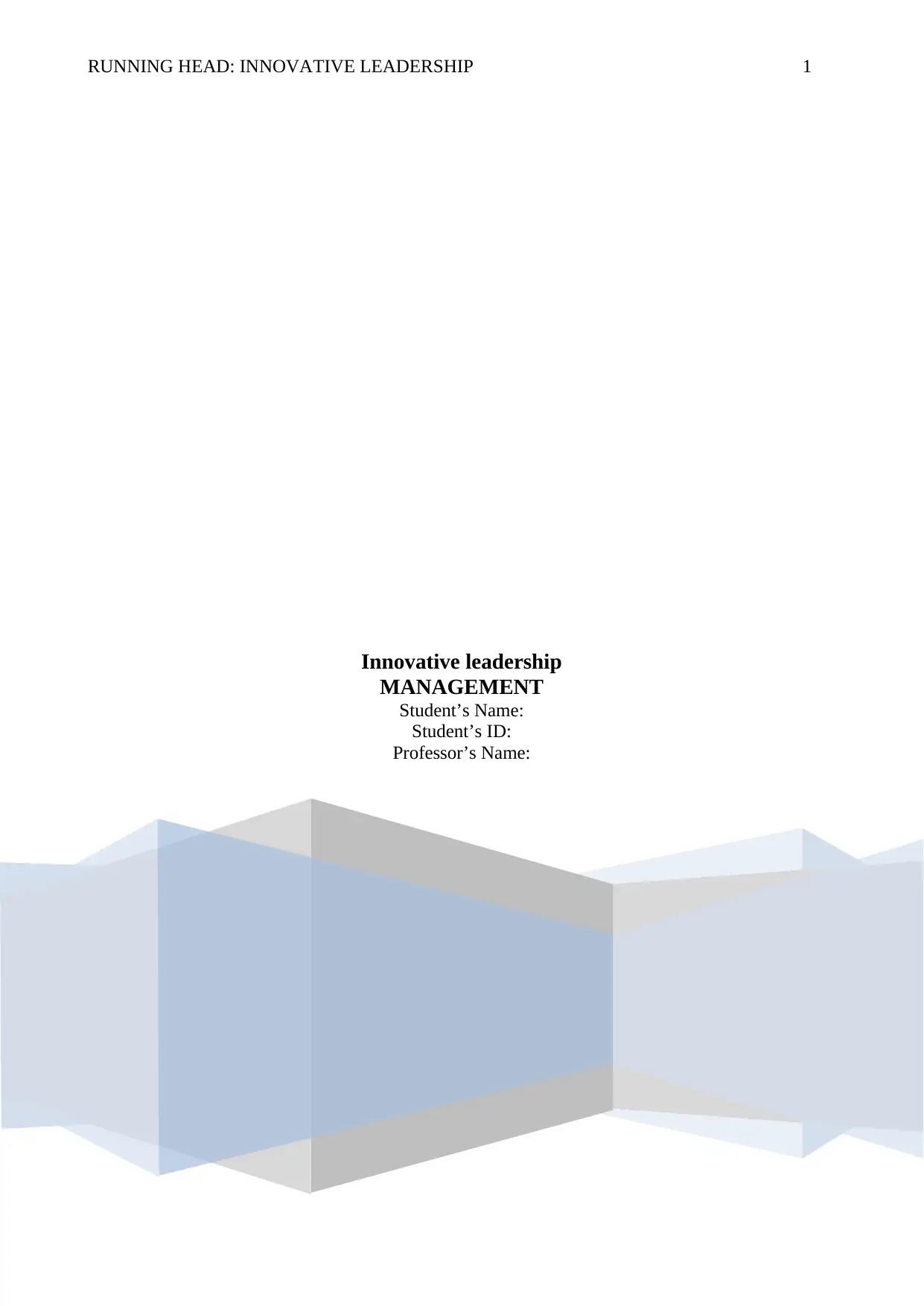
Innovative leadership
MANAGEMENT
Student’s Name:
Student’s ID:
Professor’s Name:
RUNNING HEAD: INNOVATIVE LEADERSHIP 1
MANAGEMENT
Student’s Name:
Student’s ID:
Professor’s Name:
RUNNING HEAD: INNOVATIVE LEADERSHIP 1
Paraphrase This Document
Need a fresh take? Get an instant paraphrase of this document with our AI Paraphraser
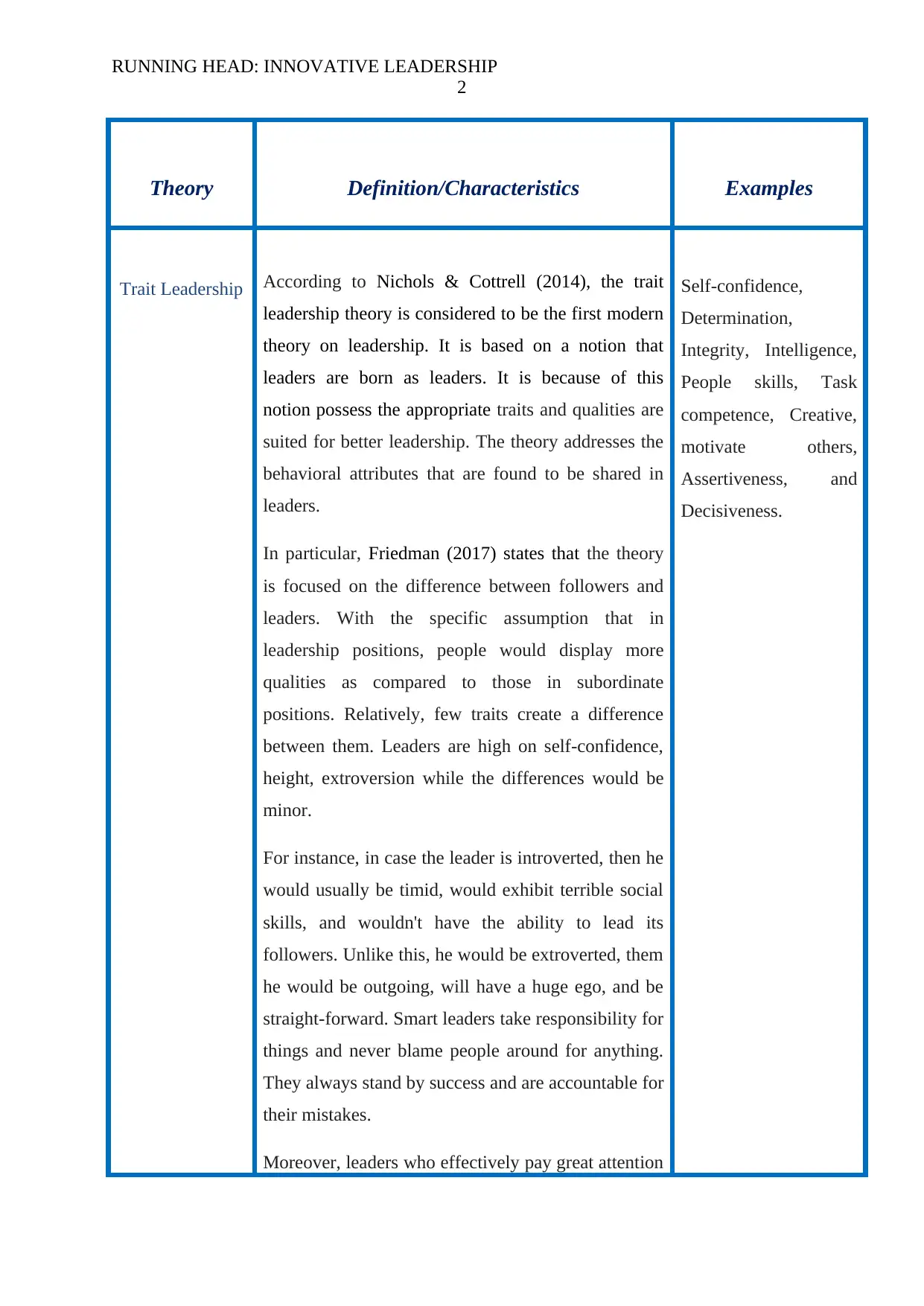
RUNNING HEAD: INNOVATIVE LEADERSHIP
2
Theory Definition/Characteristics Examples
Trait Leadership According to Nichols & Cottrell (2014), the trait
leadership theory is considered to be the first modern
theory on leadership. It is based on a notion that
leaders are born as leaders. It is because of this
notion possess the appropriate traits and qualities are
suited for better leadership. The theory addresses the
behavioral attributes that are found to be shared in
leaders.
In particular, Friedman (2017) states that the theory
is focused on the difference between followers and
leaders. With the specific assumption that in
leadership positions, people would display more
qualities as compared to those in subordinate
positions. Relatively, few traits create a difference
between them. Leaders are high on self-confidence,
height, extroversion while the differences would be
minor.
For instance, in case the leader is introverted, then he
would usually be timid, would exhibit terrible social
skills, and wouldn't have the ability to lead its
followers. Unlike this, he would be extroverted, them
he would be outgoing, will have a huge ego, and be
straight-forward. Smart leaders take responsibility for
things and never blame people around for anything.
They always stand by success and are accountable for
their mistakes.
Moreover, leaders who effectively pay great attention
Self-confidence,
Determination,
Integrity, Intelligence,
People skills, Task
competence, Creative,
motivate others,
Assertiveness, and
Decisiveness.
2
Theory Definition/Characteristics Examples
Trait Leadership According to Nichols & Cottrell (2014), the trait
leadership theory is considered to be the first modern
theory on leadership. It is based on a notion that
leaders are born as leaders. It is because of this
notion possess the appropriate traits and qualities are
suited for better leadership. The theory addresses the
behavioral attributes that are found to be shared in
leaders.
In particular, Friedman (2017) states that the theory
is focused on the difference between followers and
leaders. With the specific assumption that in
leadership positions, people would display more
qualities as compared to those in subordinate
positions. Relatively, few traits create a difference
between them. Leaders are high on self-confidence,
height, extroversion while the differences would be
minor.
For instance, in case the leader is introverted, then he
would usually be timid, would exhibit terrible social
skills, and wouldn't have the ability to lead its
followers. Unlike this, he would be extroverted, them
he would be outgoing, will have a huge ego, and be
straight-forward. Smart leaders take responsibility for
things and never blame people around for anything.
They always stand by success and are accountable for
their mistakes.
Moreover, leaders who effectively pay great attention
Self-confidence,
Determination,
Integrity, Intelligence,
People skills, Task
competence, Creative,
motivate others,
Assertiveness, and
Decisiveness.
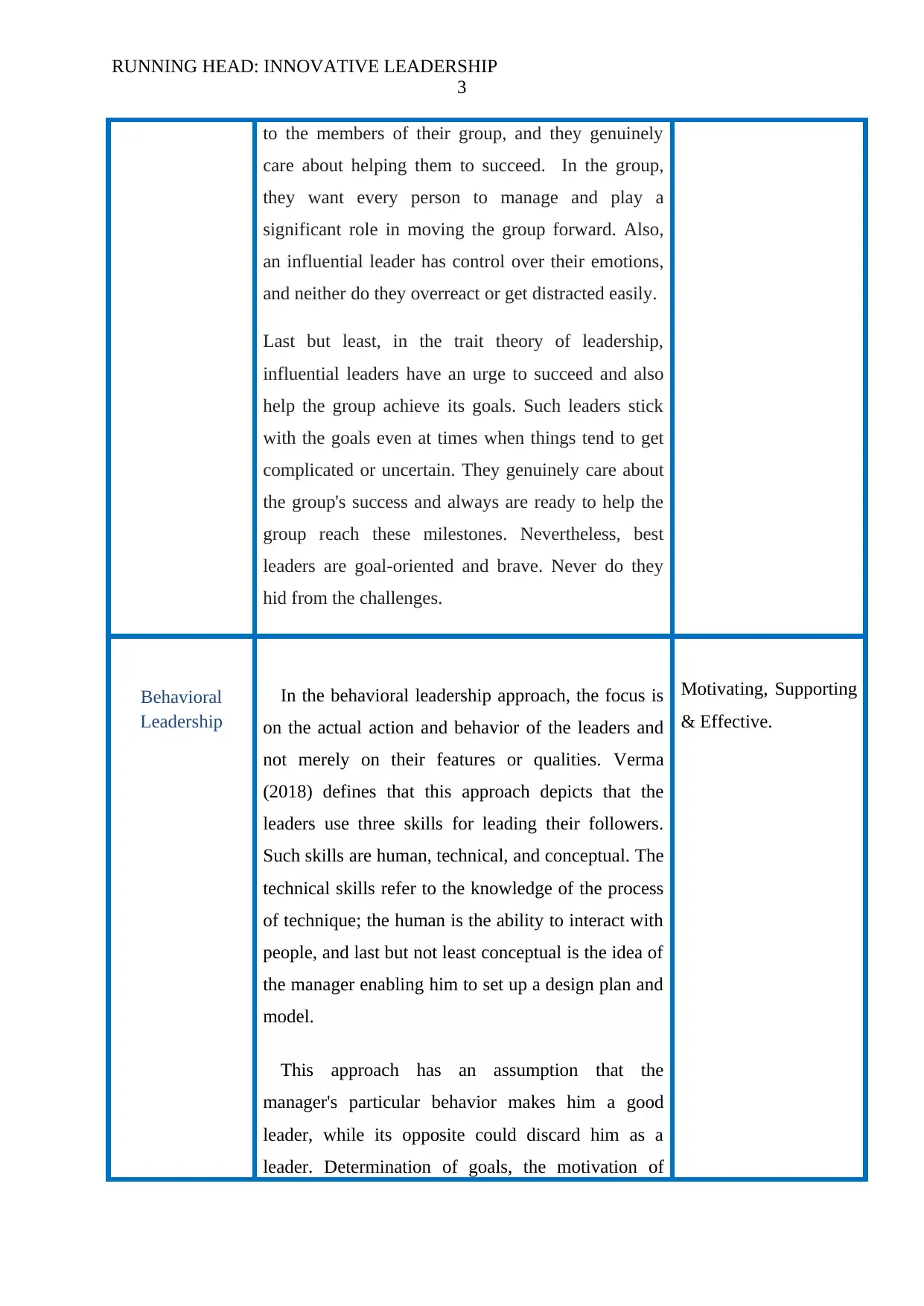
RUNNING HEAD: INNOVATIVE LEADERSHIP
3
to the members of their group, and they genuinely
care about helping them to succeed. In the group,
they want every person to manage and play a
significant role in moving the group forward. Also,
an influential leader has control over their emotions,
and neither do they overreact or get distracted easily.
Last but least, in the trait theory of leadership,
influential leaders have an urge to succeed and also
help the group achieve its goals. Such leaders stick
with the goals even at times when things tend to get
complicated or uncertain. They genuinely care about
the group's success and always are ready to help the
group reach these milestones. Nevertheless, best
leaders are goal-oriented and brave. Never do they
hid from the challenges.
Behavioral
Leadership
In the behavioral leadership approach, the focus is
on the actual action and behavior of the leaders and
not merely on their features or qualities. Verma
(2018) defines that this approach depicts that the
leaders use three skills for leading their followers.
Such skills are human, technical, and conceptual. The
technical skills refer to the knowledge of the process
of technique; the human is the ability to interact with
people, and last but not least conceptual is the idea of
the manager enabling him to set up a design plan and
model.
This approach has an assumption that the
manager's particular behavior makes him a good
leader, while its opposite could discard him as a
leader. Determination of goals, the motivation of
Motivating, Supporting
& Effective.
3
to the members of their group, and they genuinely
care about helping them to succeed. In the group,
they want every person to manage and play a
significant role in moving the group forward. Also,
an influential leader has control over their emotions,
and neither do they overreact or get distracted easily.
Last but least, in the trait theory of leadership,
influential leaders have an urge to succeed and also
help the group achieve its goals. Such leaders stick
with the goals even at times when things tend to get
complicated or uncertain. They genuinely care about
the group's success and always are ready to help the
group reach these milestones. Nevertheless, best
leaders are goal-oriented and brave. Never do they
hid from the challenges.
Behavioral
Leadership
In the behavioral leadership approach, the focus is
on the actual action and behavior of the leaders and
not merely on their features or qualities. Verma
(2018) defines that this approach depicts that the
leaders use three skills for leading their followers.
Such skills are human, technical, and conceptual. The
technical skills refer to the knowledge of the process
of technique; the human is the ability to interact with
people, and last but not least conceptual is the idea of
the manager enabling him to set up a design plan and
model.
This approach has an assumption that the
manager's particular behavior makes him a good
leader, while its opposite could discard him as a
leader. Determination of goals, the motivation of
Motivating, Supporting
& Effective.
⊘ This is a preview!⊘
Do you want full access?
Subscribe today to unlock all pages.

Trusted by 1+ million students worldwide
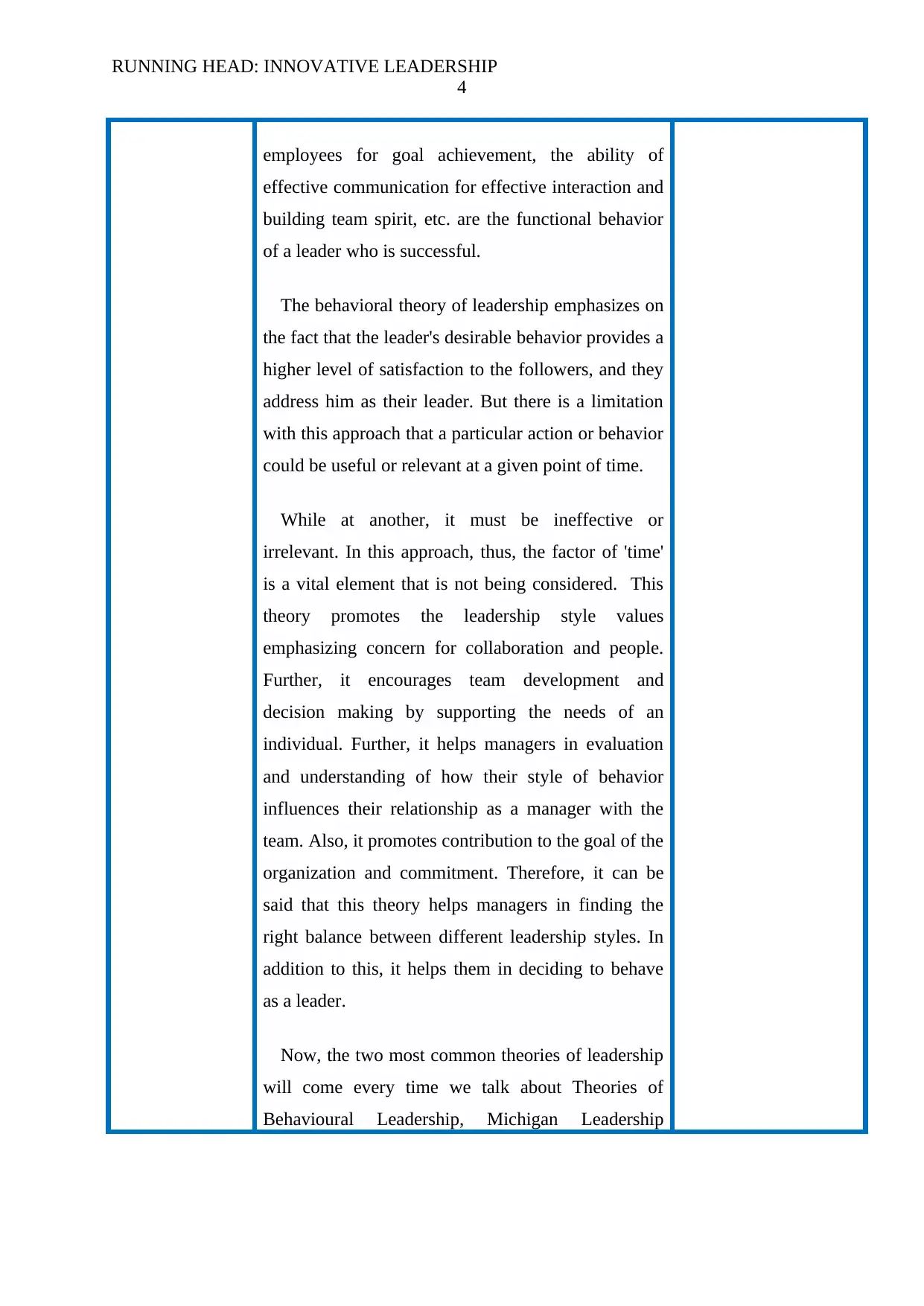
RUNNING HEAD: INNOVATIVE LEADERSHIP
4
employees for goal achievement, the ability of
effective communication for effective interaction and
building team spirit, etc. are the functional behavior
of a leader who is successful.
The behavioral theory of leadership emphasizes on
the fact that the leader's desirable behavior provides a
higher level of satisfaction to the followers, and they
address him as their leader. But there is a limitation
with this approach that a particular action or behavior
could be useful or relevant at a given point of time.
While at another, it must be ineffective or
irrelevant. In this approach, thus, the factor of 'time'
is a vital element that is not being considered. This
theory promotes the leadership style values
emphasizing concern for collaboration and people.
Further, it encourages team development and
decision making by supporting the needs of an
individual. Further, it helps managers in evaluation
and understanding of how their style of behavior
influences their relationship as a manager with the
team. Also, it promotes contribution to the goal of the
organization and commitment. Therefore, it can be
said that this theory helps managers in finding the
right balance between different leadership styles. In
addition to this, it helps them in deciding to behave
as a leader.
Now, the two most common theories of leadership
will come every time we talk about Theories of
Behavioural Leadership, Michigan Leadership
4
employees for goal achievement, the ability of
effective communication for effective interaction and
building team spirit, etc. are the functional behavior
of a leader who is successful.
The behavioral theory of leadership emphasizes on
the fact that the leader's desirable behavior provides a
higher level of satisfaction to the followers, and they
address him as their leader. But there is a limitation
with this approach that a particular action or behavior
could be useful or relevant at a given point of time.
While at another, it must be ineffective or
irrelevant. In this approach, thus, the factor of 'time'
is a vital element that is not being considered. This
theory promotes the leadership style values
emphasizing concern for collaboration and people.
Further, it encourages team development and
decision making by supporting the needs of an
individual. Further, it helps managers in evaluation
and understanding of how their style of behavior
influences their relationship as a manager with the
team. Also, it promotes contribution to the goal of the
organization and commitment. Therefore, it can be
said that this theory helps managers in finding the
right balance between different leadership styles. In
addition to this, it helps them in deciding to behave
as a leader.
Now, the two most common theories of leadership
will come every time we talk about Theories of
Behavioural Leadership, Michigan Leadership
Paraphrase This Document
Need a fresh take? Get an instant paraphrase of this document with our AI Paraphraser
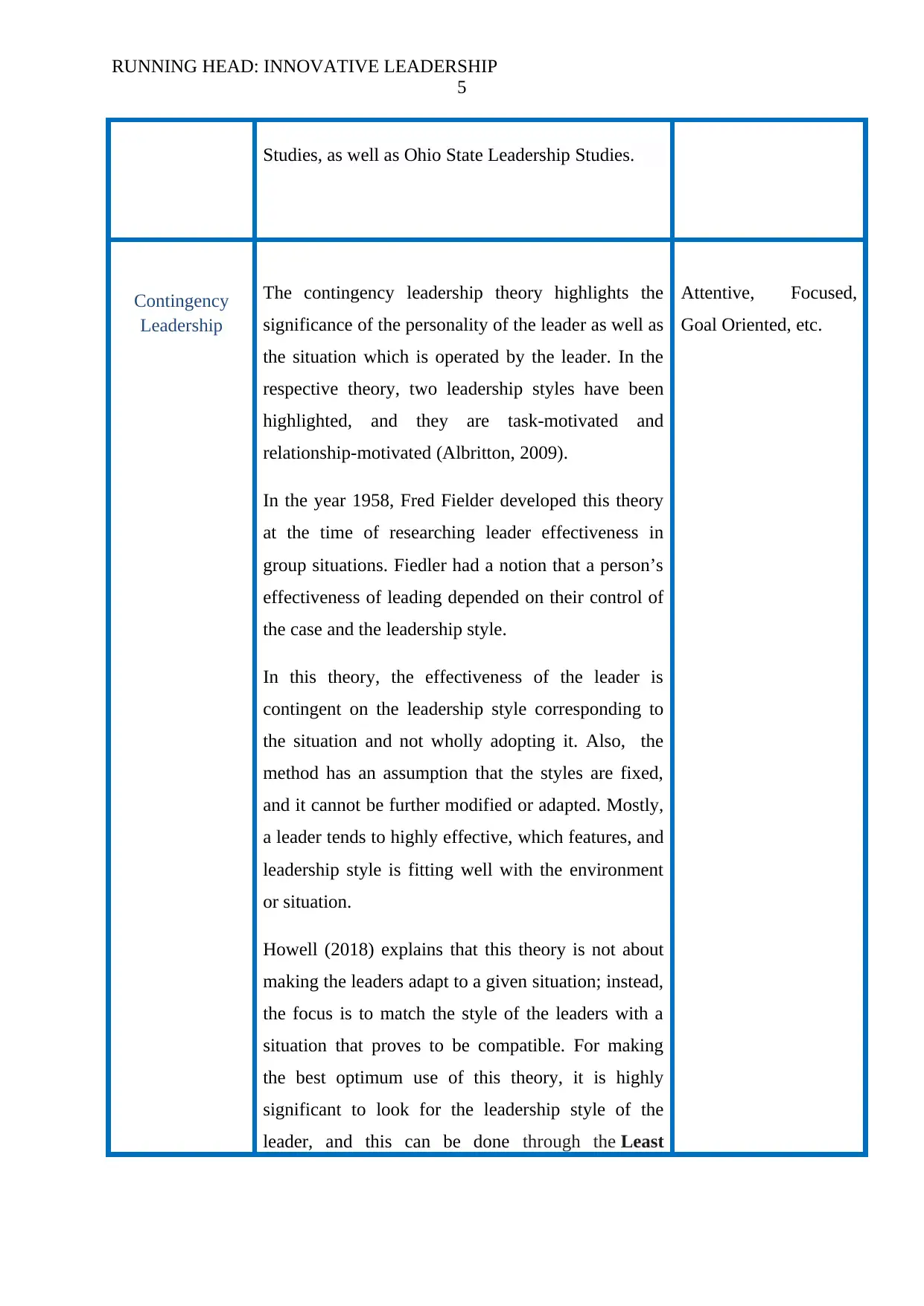
RUNNING HEAD: INNOVATIVE LEADERSHIP
5
Studies, as well as Ohio State Leadership Studies.
Contingency
Leadership
The contingency leadership theory highlights the
significance of the personality of the leader as well as
the situation which is operated by the leader. In the
respective theory, two leadership styles have been
highlighted, and they are task-motivated and
relationship-motivated (Albritton, 2009).
In the year 1958, Fred Fielder developed this theory
at the time of researching leader effectiveness in
group situations. Fiedler had a notion that a person’s
effectiveness of leading depended on their control of
the case and the leadership style.
In this theory, the effectiveness of the leader is
contingent on the leadership style corresponding to
the situation and not wholly adopting it. Also, the
method has an assumption that the styles are fixed,
and it cannot be further modified or adapted. Mostly,
a leader tends to highly effective, which features, and
leadership style is fitting well with the environment
or situation.
Howell (2018) explains that this theory is not about
making the leaders adapt to a given situation; instead,
the focus is to match the style of the leaders with a
situation that proves to be compatible. For making
the best optimum use of this theory, it is highly
significant to look for the leadership style of the
leader, and this can be done through the Least
Attentive, Focused,
Goal Oriented, etc.
5
Studies, as well as Ohio State Leadership Studies.
Contingency
Leadership
The contingency leadership theory highlights the
significance of the personality of the leader as well as
the situation which is operated by the leader. In the
respective theory, two leadership styles have been
highlighted, and they are task-motivated and
relationship-motivated (Albritton, 2009).
In the year 1958, Fred Fielder developed this theory
at the time of researching leader effectiveness in
group situations. Fiedler had a notion that a person’s
effectiveness of leading depended on their control of
the case and the leadership style.
In this theory, the effectiveness of the leader is
contingent on the leadership style corresponding to
the situation and not wholly adopting it. Also, the
method has an assumption that the styles are fixed,
and it cannot be further modified or adapted. Mostly,
a leader tends to highly effective, which features, and
leadership style is fitting well with the environment
or situation.
Howell (2018) explains that this theory is not about
making the leaders adapt to a given situation; instead,
the focus is to match the style of the leaders with a
situation that proves to be compatible. For making
the best optimum use of this theory, it is highly
significant to look for the leadership style of the
leader, and this can be done through the Least
Attentive, Focused,
Goal Oriented, etc.
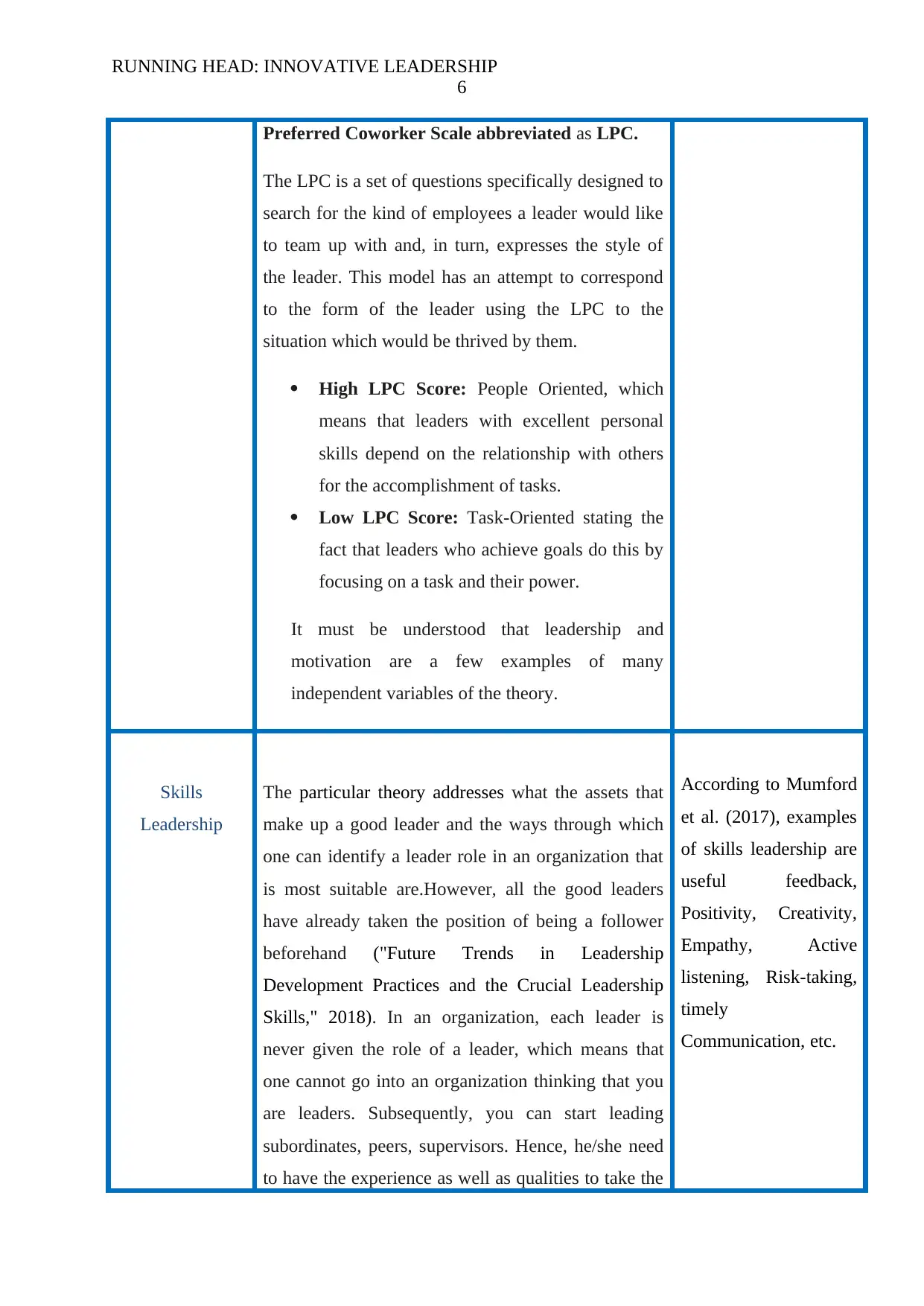
RUNNING HEAD: INNOVATIVE LEADERSHIP
6
Preferred Coworker Scale abbreviated as LPC.
The LPC is a set of questions specifically designed to
search for the kind of employees a leader would like
to team up with and, in turn, expresses the style of
the leader. This model has an attempt to correspond
to the form of the leader using the LPC to the
situation which would be thrived by them.
High LPC Score: People Oriented, which
means that leaders with excellent personal
skills depend on the relationship with others
for the accomplishment of tasks.
Low LPC Score: Task-Oriented stating the
fact that leaders who achieve goals do this by
focusing on a task and their power.
It must be understood that leadership and
motivation are a few examples of many
independent variables of the theory.
Skills
Leadership
The particular theory addresses what the assets that
make up a good leader and the ways through which
one can identify a leader role in an organization that
is most suitable are.However, all the good leaders
have already taken the position of being a follower
beforehand ("Future Trends in Leadership
Development Practices and the Crucial Leadership
Skills," 2018). In an organization, each leader is
never given the role of a leader, which means that
one cannot go into an organization thinking that you
are leaders. Subsequently, you can start leading
subordinates, peers, supervisors. Hence, he/she need
to have the experience as well as qualities to take the
According to Mumford
et al. (2017), examples
of skills leadership are
useful feedback,
Positivity, Creativity,
Empathy, Active
listening, Risk-taking,
timely
Communication, etc.
6
Preferred Coworker Scale abbreviated as LPC.
The LPC is a set of questions specifically designed to
search for the kind of employees a leader would like
to team up with and, in turn, expresses the style of
the leader. This model has an attempt to correspond
to the form of the leader using the LPC to the
situation which would be thrived by them.
High LPC Score: People Oriented, which
means that leaders with excellent personal
skills depend on the relationship with others
for the accomplishment of tasks.
Low LPC Score: Task-Oriented stating the
fact that leaders who achieve goals do this by
focusing on a task and their power.
It must be understood that leadership and
motivation are a few examples of many
independent variables of the theory.
Skills
Leadership
The particular theory addresses what the assets that
make up a good leader and the ways through which
one can identify a leader role in an organization that
is most suitable are.However, all the good leaders
have already taken the position of being a follower
beforehand ("Future Trends in Leadership
Development Practices and the Crucial Leadership
Skills," 2018). In an organization, each leader is
never given the role of a leader, which means that
one cannot go into an organization thinking that you
are leaders. Subsequently, you can start leading
subordinates, peers, supervisors. Hence, he/she need
to have the experience as well as qualities to take the
According to Mumford
et al. (2017), examples
of skills leadership are
useful feedback,
Positivity, Creativity,
Empathy, Active
listening, Risk-taking,
timely
Communication, etc.
⊘ This is a preview!⊘
Do you want full access?
Subscribe today to unlock all pages.

Trusted by 1+ million students worldwide
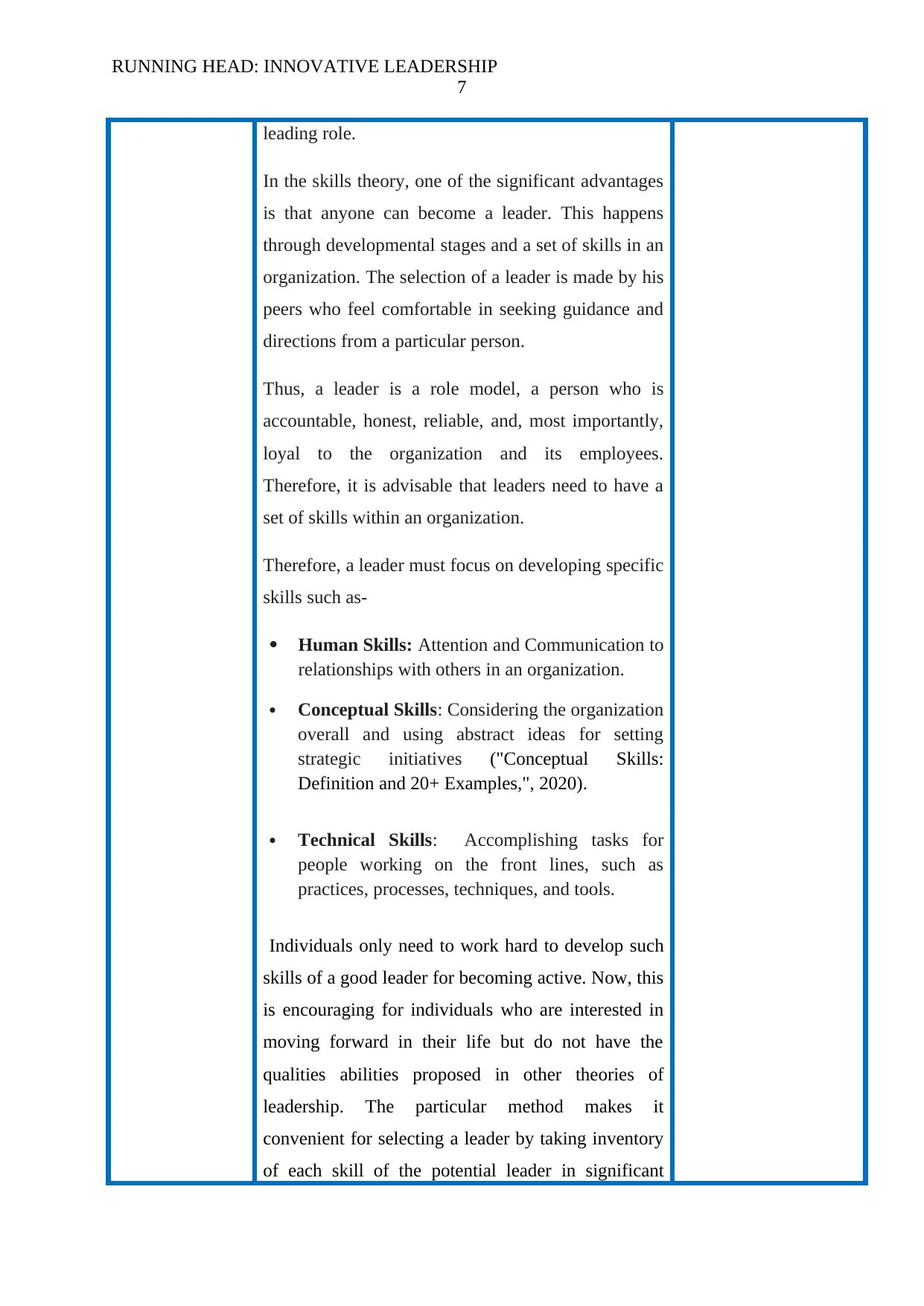
RUNNING HEAD: INNOVATIVE LEADERSHIP
7
leading role.
In the skills theory, one of the significant advantages
is that anyone can become a leader. This happens
through developmental stages and a set of skills in an
organization. The selection of a leader is made by his
peers who feel comfortable in seeking guidance and
directions from a particular person.
Thus, a leader is a role model, a person who is
accountable, honest, reliable, and, most importantly,
loyal to the organization and its employees.
Therefore, it is advisable that leaders need to have a
set of skills within an organization.
Therefore, a leader must focus on developing specific
skills such as-
Human Skills: Attention and Communication to
relationships with others in an organization.
Conceptual Skills: Considering the organization
overall and using abstract ideas for setting
strategic initiatives ("Conceptual Skills:
Definition and 20+ Examples,", 2020).
Technical Skills: Accomplishing tasks for
people working on the front lines, such as
practices, processes, techniques, and tools.
Individuals only need to work hard to develop such
skills of a good leader for becoming active. Now, this
is encouraging for individuals who are interested in
moving forward in their life but do not have the
qualities abilities proposed in other theories of
leadership. The particular method makes it
convenient for selecting a leader by taking inventory
of each skill of the potential leader in significant
7
leading role.
In the skills theory, one of the significant advantages
is that anyone can become a leader. This happens
through developmental stages and a set of skills in an
organization. The selection of a leader is made by his
peers who feel comfortable in seeking guidance and
directions from a particular person.
Thus, a leader is a role model, a person who is
accountable, honest, reliable, and, most importantly,
loyal to the organization and its employees.
Therefore, it is advisable that leaders need to have a
set of skills within an organization.
Therefore, a leader must focus on developing specific
skills such as-
Human Skills: Attention and Communication to
relationships with others in an organization.
Conceptual Skills: Considering the organization
overall and using abstract ideas for setting
strategic initiatives ("Conceptual Skills:
Definition and 20+ Examples,", 2020).
Technical Skills: Accomplishing tasks for
people working on the front lines, such as
practices, processes, techniques, and tools.
Individuals only need to work hard to develop such
skills of a good leader for becoming active. Now, this
is encouraging for individuals who are interested in
moving forward in their life but do not have the
qualities abilities proposed in other theories of
leadership. The particular method makes it
convenient for selecting a leader by taking inventory
of each skill of the potential leader in significant
Paraphrase This Document
Need a fresh take? Get an instant paraphrase of this document with our AI Paraphraser
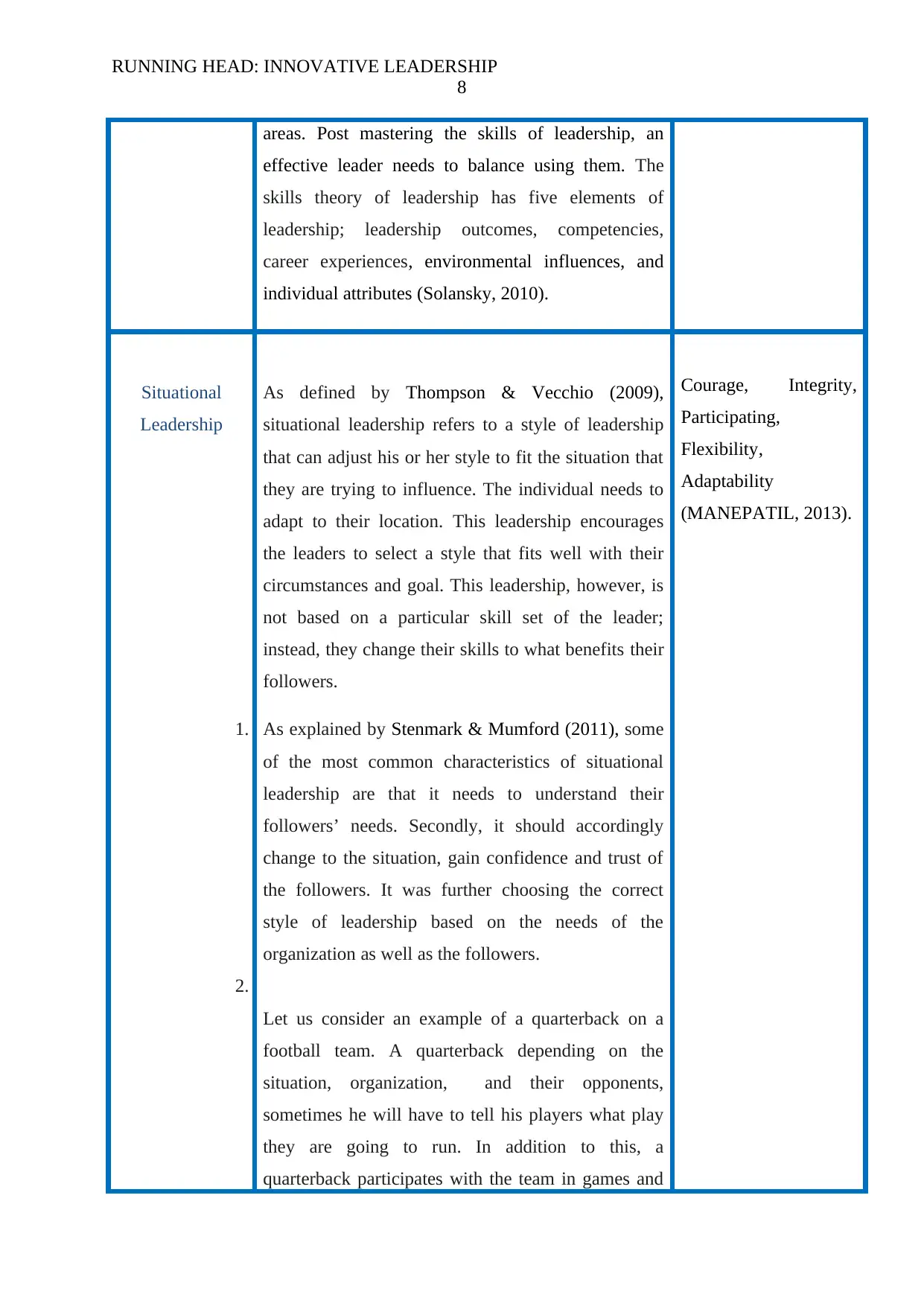
RUNNING HEAD: INNOVATIVE LEADERSHIP
8
areas. Post mastering the skills of leadership, an
effective leader needs to balance using them. The
skills theory of leadership has five elements of
leadership; leadership outcomes, competencies,
career experiences, environmental influences, and
individual attributes (Solansky, 2010).
Situational
Leadership
As defined by Thompson & Vecchio (2009),
situational leadership refers to a style of leadership
that can adjust his or her style to fit the situation that
they are trying to influence. The individual needs to
adapt to their location. This leadership encourages
the leaders to select a style that fits well with their
circumstances and goal. This leadership, however, is
not based on a particular skill set of the leader;
instead, they change their skills to what benefits their
followers.
1. As explained by Stenmark & Mumford (2011), some
of the most common characteristics of situational
leadership are that it needs to understand their
followers’ needs. Secondly, it should accordingly
change to the situation, gain confidence and trust of
the followers. It was further choosing the correct
style of leadership based on the needs of the
organization as well as the followers.
2.
Let us consider an example of a quarterback on a
football team. A quarterback depending on the
situation, organization, and their opponents,
sometimes he will have to tell his players what play
they are going to run. In addition to this, a
quarterback participates with the team in games and
Courage, Integrity,
Participating,
Flexibility,
Adaptability
(MANEPATIL, 2013).
8
areas. Post mastering the skills of leadership, an
effective leader needs to balance using them. The
skills theory of leadership has five elements of
leadership; leadership outcomes, competencies,
career experiences, environmental influences, and
individual attributes (Solansky, 2010).
Situational
Leadership
As defined by Thompson & Vecchio (2009),
situational leadership refers to a style of leadership
that can adjust his or her style to fit the situation that
they are trying to influence. The individual needs to
adapt to their location. This leadership encourages
the leaders to select a style that fits well with their
circumstances and goal. This leadership, however, is
not based on a particular skill set of the leader;
instead, they change their skills to what benefits their
followers.
1. As explained by Stenmark & Mumford (2011), some
of the most common characteristics of situational
leadership are that it needs to understand their
followers’ needs. Secondly, it should accordingly
change to the situation, gain confidence and trust of
the followers. It was further choosing the correct
style of leadership based on the needs of the
organization as well as the followers.
2.
Let us consider an example of a quarterback on a
football team. A quarterback depending on the
situation, organization, and their opponents,
sometimes he will have to tell his players what play
they are going to run. In addition to this, a
quarterback participates with the team in games and
Courage, Integrity,
Participating,
Flexibility,
Adaptability
(MANEPATIL, 2013).
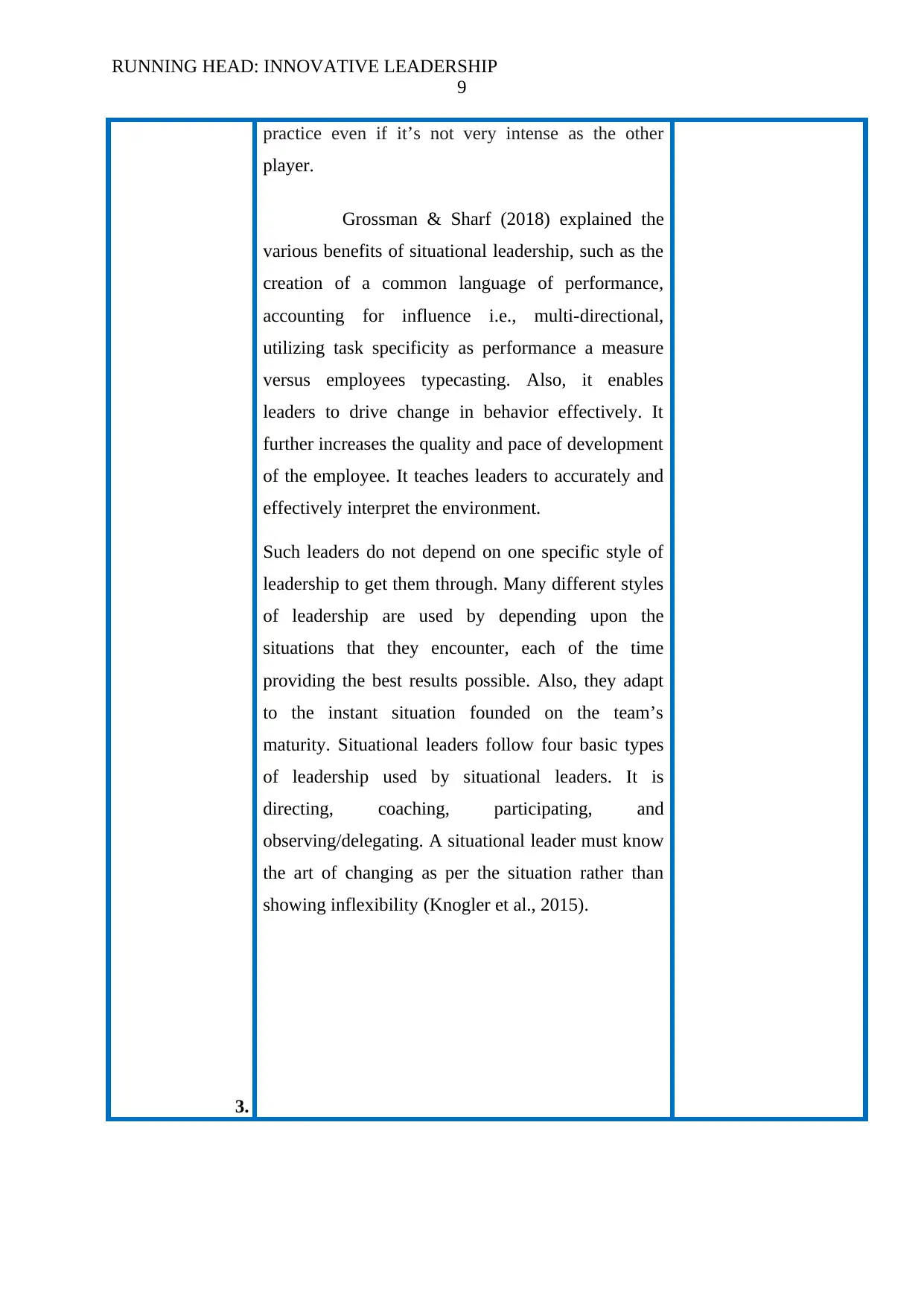
RUNNING HEAD: INNOVATIVE LEADERSHIP
9
practice even if it’s not very intense as the other
player.
Grossman & Sharf (2018) explained the
various benefits of situational leadership, such as the
creation of a common language of performance,
accounting for influence i.e., multi-directional,
utilizing task specificity as performance a measure
versus employees typecasting. Also, it enables
leaders to drive change in behavior effectively. It
further increases the quality and pace of development
of the employee. It teaches leaders to accurately and
effectively interpret the environment.
Such leaders do not depend on one specific style of
leadership to get them through. Many different styles
of leadership are used by depending upon the
situations that they encounter, each of the time
providing the best results possible. Also, they adapt
to the instant situation founded on the team’s
maturity. Situational leaders follow four basic types
of leadership used by situational leaders. It is
directing, coaching, participating, and
observing/delegating. A situational leader must know
the art of changing as per the situation rather than
showing inflexibility (Knogler et al., 2015).
3.
9
practice even if it’s not very intense as the other
player.
Grossman & Sharf (2018) explained the
various benefits of situational leadership, such as the
creation of a common language of performance,
accounting for influence i.e., multi-directional,
utilizing task specificity as performance a measure
versus employees typecasting. Also, it enables
leaders to drive change in behavior effectively. It
further increases the quality and pace of development
of the employee. It teaches leaders to accurately and
effectively interpret the environment.
Such leaders do not depend on one specific style of
leadership to get them through. Many different styles
of leadership are used by depending upon the
situations that they encounter, each of the time
providing the best results possible. Also, they adapt
to the instant situation founded on the team’s
maturity. Situational leaders follow four basic types
of leadership used by situational leaders. It is
directing, coaching, participating, and
observing/delegating. A situational leader must know
the art of changing as per the situation rather than
showing inflexibility (Knogler et al., 2015).
3.
⊘ This is a preview!⊘
Do you want full access?
Subscribe today to unlock all pages.

Trusted by 1+ million students worldwide
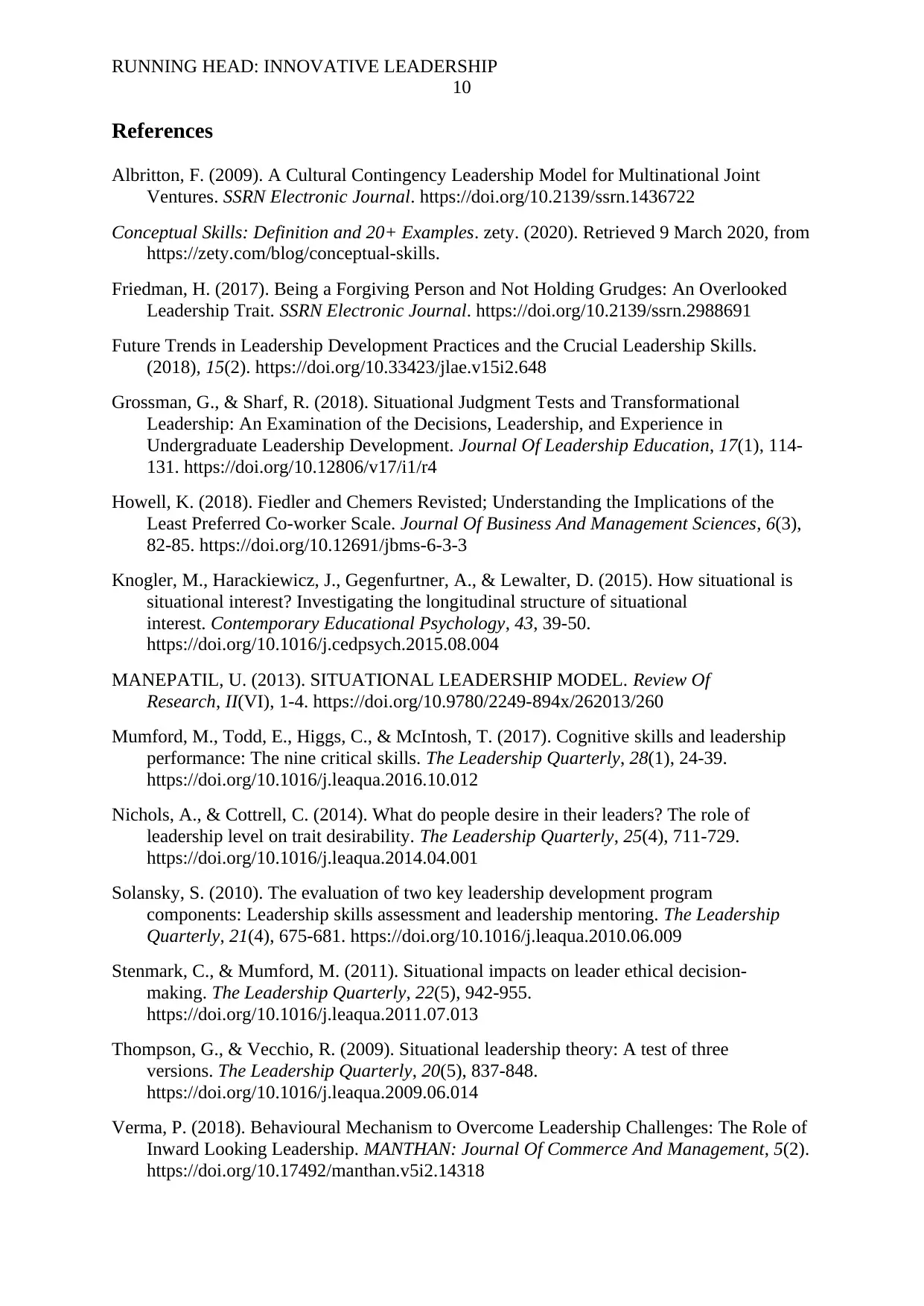
RUNNING HEAD: INNOVATIVE LEADERSHIP
10
References
Albritton, F. (2009). A Cultural Contingency Leadership Model for Multinational Joint
Ventures. SSRN Electronic Journal. https://doi.org/10.2139/ssrn.1436722
Conceptual Skills: Definition and 20+ Examples. zety. (2020). Retrieved 9 March 2020, from
https://zety.com/blog/conceptual-skills.
Friedman, H. (2017). Being a Forgiving Person and Not Holding Grudges: An Overlooked
Leadership Trait. SSRN Electronic Journal. https://doi.org/10.2139/ssrn.2988691
Future Trends in Leadership Development Practices and the Crucial Leadership Skills.
(2018), 15(2). https://doi.org/10.33423/jlae.v15i2.648
Grossman, G., & Sharf, R. (2018). Situational Judgment Tests and Transformational
Leadership: An Examination of the Decisions, Leadership, and Experience in
Undergraduate Leadership Development. Journal Of Leadership Education, 17(1), 114-
131. https://doi.org/10.12806/v17/i1/r4
Howell, K. (2018). Fiedler and Chemers Revisted; Understanding the Implications of the
Least Preferred Co-worker Scale. Journal Of Business And Management Sciences, 6(3),
82-85. https://doi.org/10.12691/jbms-6-3-3
Knogler, M., Harackiewicz, J., Gegenfurtner, A., & Lewalter, D. (2015). How situational is
situational interest? Investigating the longitudinal structure of situational
interest. Contemporary Educational Psychology, 43, 39-50.
https://doi.org/10.1016/j.cedpsych.2015.08.004
MANEPATIL, U. (2013). SITUATIONAL LEADERSHIP MODEL. Review Of
Research, II(VI), 1-4. https://doi.org/10.9780/2249-894x/262013/260
Mumford, M., Todd, E., Higgs, C., & McIntosh, T. (2017). Cognitive skills and leadership
performance: The nine critical skills. The Leadership Quarterly, 28(1), 24-39.
https://doi.org/10.1016/j.leaqua.2016.10.012
Nichols, A., & Cottrell, C. (2014). What do people desire in their leaders? The role of
leadership level on trait desirability. The Leadership Quarterly, 25(4), 711-729.
https://doi.org/10.1016/j.leaqua.2014.04.001
Solansky, S. (2010). The evaluation of two key leadership development program
components: Leadership skills assessment and leadership mentoring. The Leadership
Quarterly, 21(4), 675-681. https://doi.org/10.1016/j.leaqua.2010.06.009
Stenmark, C., & Mumford, M. (2011). Situational impacts on leader ethical decision-
making. The Leadership Quarterly, 22(5), 942-955.
https://doi.org/10.1016/j.leaqua.2011.07.013
Thompson, G., & Vecchio, R. (2009). Situational leadership theory: A test of three
versions. The Leadership Quarterly, 20(5), 837-848.
https://doi.org/10.1016/j.leaqua.2009.06.014
Verma, P. (2018). Behavioural Mechanism to Overcome Leadership Challenges: The Role of
Inward Looking Leadership. MANTHAN: Journal Of Commerce And Management, 5(2).
https://doi.org/10.17492/manthan.v5i2.14318
10
References
Albritton, F. (2009). A Cultural Contingency Leadership Model for Multinational Joint
Ventures. SSRN Electronic Journal. https://doi.org/10.2139/ssrn.1436722
Conceptual Skills: Definition and 20+ Examples. zety. (2020). Retrieved 9 March 2020, from
https://zety.com/blog/conceptual-skills.
Friedman, H. (2017). Being a Forgiving Person and Not Holding Grudges: An Overlooked
Leadership Trait. SSRN Electronic Journal. https://doi.org/10.2139/ssrn.2988691
Future Trends in Leadership Development Practices and the Crucial Leadership Skills.
(2018), 15(2). https://doi.org/10.33423/jlae.v15i2.648
Grossman, G., & Sharf, R. (2018). Situational Judgment Tests and Transformational
Leadership: An Examination of the Decisions, Leadership, and Experience in
Undergraduate Leadership Development. Journal Of Leadership Education, 17(1), 114-
131. https://doi.org/10.12806/v17/i1/r4
Howell, K. (2018). Fiedler and Chemers Revisted; Understanding the Implications of the
Least Preferred Co-worker Scale. Journal Of Business And Management Sciences, 6(3),
82-85. https://doi.org/10.12691/jbms-6-3-3
Knogler, M., Harackiewicz, J., Gegenfurtner, A., & Lewalter, D. (2015). How situational is
situational interest? Investigating the longitudinal structure of situational
interest. Contemporary Educational Psychology, 43, 39-50.
https://doi.org/10.1016/j.cedpsych.2015.08.004
MANEPATIL, U. (2013). SITUATIONAL LEADERSHIP MODEL. Review Of
Research, II(VI), 1-4. https://doi.org/10.9780/2249-894x/262013/260
Mumford, M., Todd, E., Higgs, C., & McIntosh, T. (2017). Cognitive skills and leadership
performance: The nine critical skills. The Leadership Quarterly, 28(1), 24-39.
https://doi.org/10.1016/j.leaqua.2016.10.012
Nichols, A., & Cottrell, C. (2014). What do people desire in their leaders? The role of
leadership level on trait desirability. The Leadership Quarterly, 25(4), 711-729.
https://doi.org/10.1016/j.leaqua.2014.04.001
Solansky, S. (2010). The evaluation of two key leadership development program
components: Leadership skills assessment and leadership mentoring. The Leadership
Quarterly, 21(4), 675-681. https://doi.org/10.1016/j.leaqua.2010.06.009
Stenmark, C., & Mumford, M. (2011). Situational impacts on leader ethical decision-
making. The Leadership Quarterly, 22(5), 942-955.
https://doi.org/10.1016/j.leaqua.2011.07.013
Thompson, G., & Vecchio, R. (2009). Situational leadership theory: A test of three
versions. The Leadership Quarterly, 20(5), 837-848.
https://doi.org/10.1016/j.leaqua.2009.06.014
Verma, P. (2018). Behavioural Mechanism to Overcome Leadership Challenges: The Role of
Inward Looking Leadership. MANTHAN: Journal Of Commerce And Management, 5(2).
https://doi.org/10.17492/manthan.v5i2.14318
Paraphrase This Document
Need a fresh take? Get an instant paraphrase of this document with our AI Paraphraser

RUNNING HEAD: INNOVATIVE LEADERSHIP
11
.
11
.

RUNNING HEAD: INNOVATIVE LEADERSHIP
12
12
⊘ This is a preview!⊘
Do you want full access?
Subscribe today to unlock all pages.

Trusted by 1+ million students worldwide
1 out of 12
Related Documents
Your All-in-One AI-Powered Toolkit for Academic Success.
+13062052269
info@desklib.com
Available 24*7 on WhatsApp / Email
![[object Object]](/_next/static/media/star-bottom.7253800d.svg)
Unlock your academic potential
Copyright © 2020–2025 A2Z Services. All Rights Reserved. Developed and managed by ZUCOL.



